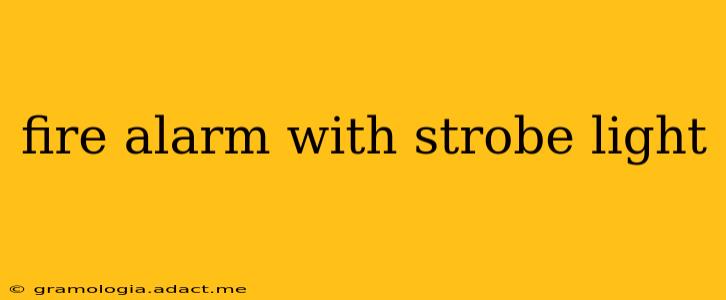Fire alarms save lives. The piercing shriek of a traditional alarm is effective for many, but what about those who are deaf or hard of hearing? This is where the addition of a strobe light becomes crucial. A fire alarm with a strobe light provides a critical visual alert, ensuring that everyone in a building, regardless of hearing ability, receives timely warning of a fire. This comprehensive guide will explore the importance of these combined systems, their functionality, and the regulations surrounding their use.
Why is a Strobe Light Important in a Fire Alarm System?
For individuals with hearing impairments, a standard audible alarm is simply ineffective. A strobe light, however, provides a clear and unmistakable visual signal. The bright flashing light penetrates even a smoky environment, drawing attention to the danger and giving individuals valuable time to evacuate. This isn't just about safety for the hearing impaired; it enhances overall building safety for everyone. A visible alert supplements the audible alarm, improving the chances of a rapid and organized evacuation.
What are the Different Types of Fire Alarms with Strobe Lights?
Fire alarms with strobe lights come in various types, offering different levels of functionality and coverage:
-
Standalone Strobe Lights: These are independent units that can be paired with existing audible alarms. They are easy to install and are a cost-effective solution for retrofitting existing systems.
-
Combination Smoke/Heat Detectors with Strobe Lights: These units combine smoke detection, heat detection, and a built-in strobe light in a single device, offering a compact and integrated solution.
-
Wireless Systems with Strobe Lights: These offer flexibility and ease of installation, especially in larger buildings. They often include features like remote monitoring and notification.
-
Centralized Strobe Systems: Larger buildings may opt for centralized strobe light systems that are triggered by a central fire alarm panel, ensuring synchronized flashing across multiple locations.
How Does a Strobe Light Work in a Fire Alarm System?
A strobe light, also known as a visual alarm, is triggered simultaneously with the audible alarm. When the alarm is activated, a powerful LED light flashes at a specific rate (typically between 1 and 2 flashes per second) according to regulations, making it highly visible even in dim light or smoke-filled conditions. The intensity and flashing rate are crucial to ensure the strobe light is easily noticeable and doesn't trigger seizures in individuals with photosensitive epilepsy.
What are the Regulations Regarding Fire Alarms with Strobe Lights?
Regulations regarding fire alarms with strobe lights vary depending on location, but generally, building codes mandate their installation in specific situations:
-
Accessibility Requirements: Many jurisdictions require the installation of visual alarms in areas designated for individuals with disabilities, including bedrooms and common areas of residential buildings and all areas of commercial spaces.
-
Specific Building Types: Certain types of buildings, such as schools, hospitals, and care facilities, may have stricter requirements for visual alarms to ensure the safety of occupants.
-
Compliance with ADA (Americans with Disabilities Act): In the United States, the ADA requires that fire alarm systems in accessible spaces include strobe lights.
Where Should I Install Fire Alarms with Strobe Lights?
Proper placement is key to the effectiveness of a strobe light in a fire alarm system. Consider these factors:
-
High-visibility locations: Install alarms in locations where they'll be readily seen, avoiding obstructions.
-
Strategic placement: Consider the layout of the building and the potential escape routes when placing alarms.
-
Compliance with building codes: Always adhere to local building codes and regulations.
How Often Should I Test My Fire Alarm with Strobe Light?
Regular testing is crucial to ensure your fire alarm system, including the strobe light, is functioning correctly. Conduct monthly tests to verify the audible and visual alerts are working. Annual professional inspections are also recommended to check for any issues that may affect the system's reliability.
What Should I Do if My Fire Alarm with Strobe Light Malfunctions?
If your fire alarm with strobe light malfunctions, contact a qualified fire alarm technician immediately. Do not attempt to repair the system yourself. A malfunctioning system could compromise the safety of you and those in the building.
This information is for general guidance only and should not be considered a substitute for professional advice. Always consult local building codes and regulations to ensure compliance. Your safety and the safety of those around you are paramount.
